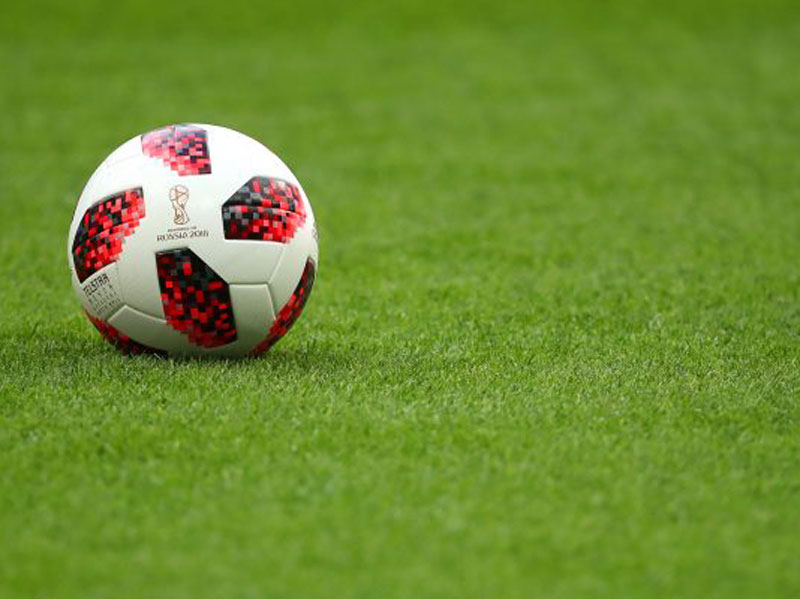World Cup Ball
The World Cup Ball has changed a lot over time, getting lighter and more technical in design. The materials have changed over time as has he manufacturer responsible for designing and providing the balls for the tournament. Below we have put together a definitive list of each official match ball at each of the World Cups, including the one which will be used later on this year in Russia.
2018 World Cup – Adidas Mechta
A different form of the Telstar 18, the Mechta is different purely because of the red colour way and will be used throughout the knockout stages of the 2018 World Cup.

The red Adidas Mechta (Getty Images)
2018 World Cup – Adidas Telstar 18
The Telstar 18 by adidas will be used in Russia later on this year. Designed to be a modern interpretation of the iconic 1970 Telstar ball, the ball only has six panels in an innovative design whereas the original Telstar had 32 panels fastened together. It is not know yet whether Adidas will produce a special edition version for the final.

The Adidas Telstar 18 will be the official ball in Russia (Getty Images)
2014 World Cup – Adidas Brazuca, Adidas Brazuca Final Rio
The Brazuca was the first World Cup ball to be named by the public. Brazuca was selected as it is an informal term for Brazilian national pride in their way of life. The design of the original Brazuca was to symbolise fluidity of Brazilian life and the Amazon river, and the bands are meant to symbolise the famous Brazilian wishbands . Additionally, having taken over two and a half years through design, construction and testing, the Brazuca was the most tested ball Adidas ever produced.

The Brazuca was the most tested ball Adidas ever proceed (Getty Images)
The Final Rio version was the same technical design but had different colours, instead having green, gold and black.

The Final Rio was the third special Final edition Adidas produced for the World Cup Final (Getty Images)
2010 World Cup – Adidas Jabulani, Adidas Jo’bulani
In the language of Zulu, Jabulani means ‘celebrate’ however this official ball was one of the most controversial balls to be created. It drew immense criticism from players and coaches because it was deemed to be too unpredictable through the air. The number 11 was a key theme in its design with there being 11 colours which were chosen to represent the 11 players on a football team, the 11 official languages of South Africa, and the 11 South African communities.

The Jabulani before a group game in 2010 (Getty Images)
For the second time, Adidas produced a special edition ball for the final the Jo’bulani. The name is in reference to Johannesburg’s nickname Jo’burg, and the gold design is to signify another nickname Johannesburg, otherwise known as the ‘City of Gold’.

The Jo’bulani is named after Johannesburg (Getty Images)
2006 World Cup – Adidas Teamgeist, Adidas Teamgeist Berlin
Adidas claimed this ball was like no other in terms of the technological design. Comprised of 14 panels, the design was supposed to enhance player control, and the design was to signify German football successes. The gold accents symbolise the gold World Cup trophy. The name of the ball is translated as ‘team spirit’. Additionally, this was the first ball to have each match date, kick off time, teams and stadiums stitched into it.

Adidas Teamgeist ball (Getty Images)
For the first time, Adidas introduced a special ball just for the final. Franz Beckenbauer said, “The FIFA World Cup final is the most important match in the history of sport. There really is no greater thing than to play in a World Cup final. That is why I think it is a fantastic idea to have a very special ball especially for this match.” The design wasn’t that different other than the gold colour way.

The Teamgeist Berlin ball before the 2006 final (Getty Images)
2002 World Cup – Adidas Fevernova
The Adidas Fevernova was a ball like no other, in terms of design and colour way. It had a special foam layer, and had thicker inner layers to increase accuracy. However many criticised it for being too light.

The Fevernova before a group game in 2002 (Getty Images)
1998 World Cup – Adidas Tricolore
The Tricolore was the first coloured ball to be used in the World Cup Finals. The blue design was to signify the french flag and the rooster tail is the traditional symbol of France and the French Football Federation.

Brazil coach Mario Zagallo holds the Tricolore ball (Getty Images)
1994 World Cup – Adidas Questra
The 1994 World Cup ball was made of five different materials and polystyrene foam which made the ball more waterproof. The name Questra derives from an ancient word meaning ‘pursuit of the stars’.

A model of the ball at the World Cup draw (Getty Images)
1990 World Cup – Adidas Etruscan Unico
The 1990 tournament was held in Italy and the ball was designed to celebrate that. The design was produced to celebrate the history of ancient Italy and the Etruscans. For example three Etruscan lion heads are present in each triad on the ball.

A referee stands with the Etruscan Unico before a match in 1990 (Getty Images)
1986 World Cup – Adidas Azteca
The Azteca was the first fully synthetic ball to be used at the World Cup. Designed with aztec frescoes, the ball would be used in Mexico in 1986.

The Azteca used in 1986 (Getty Images)
1982 World Cup – Adidas Tango Espana
The Tango Espana was the first ball to combine leather and synthetic materials and yet despite having improved water resistant qualities, the ball still had issues which meant it had to be modified several times. As a result, it was also the last leather ball used in the World Cup.

The actual 1982 World Cup final ball pictured in 2013 (Getty Images)
1978 World Cup – Adidas Tango
The design for the 1978 ball was supposed to reflect the passion and dynamism of the country of Argentina.

French coach Michel Hidalgo holds the 1978 World Cup Ball (Getty Images)
1974 World Cup – Adidas Telstar Durlast
Due to the success of the 1970 Telstar, Adidas did very little to change the 1974 ball. Some black writing instead of gold and a different coating to improve water resistance were the only significant changes.

The Adidas Telstar Durmast wasn’t changed al that much from the 1970 ball (Getty Images)
1970 World Cup – Adidas Telstar
Named after the satellite put into orbit in 1962, the Telstar was the first ball made by Adidas for the World Cup. Composed of 20 white hexagons and 12 black pentagons, the ball is iconic. It was also known as the ‘Star of Television’ because the black pentagons made it easy to see on black and white television.

The black and white design made it easier to see the Telstar on television in 1970 (Getty Images)
1966 World Cup – Slazenger Challenge 4-Star
Slazenger, a British company were tasked with making the ball for the 1966 tournament held in Britain. Made of 25 rectangular panels, the ball had no markings or branding on the ball.

Geoff Hurst stands with the ball and the famous crossbar from the 1966 final (Getty Images)
1962 World Cup – Crack Top Star
Known simply as ‘the Crack’ this ball was made of irregular shapes, which was a design never before seen.

The Crack Top Star Football (football-bals.com)
1958 World Cup – Top Star
This was the first tournament where the ball design was a competition. The winning design was a from a Swedish company, and their ball was called the Top Star. it was renowned for its waterproof waxed surface.

Garrincha takes the Top Star past a defender in 1958 (Getty Images)
1954 World Cup – Swiss World Champion
The most notable aspect of this ball was the zig-zag edges on the ball.

The 1954 World Cup Ball at the Germany Football Museum (Getty Images)
1950 World Cup – Superball Duplo T
Inflatable 12 panel ball used during the iconic 1950 World Cup where Uruguay shocked Brazil in front of nearly 200,000 people.

Brazil scoring with the Duple T in 1950 (Getty Images)
1938 World Cup – Allen
The Allen was manufactured in France and yet it is widely acknowledged that other balls were used during the tournament too. But there is no way of knowing how many.

The Allen ball in play between Czechoslovakia and Brazil (Getty Images)
1934 World Cup – Federale 102
The Second World Cup was held in Italy and as a result Mussolini insisted the ball be made there. The result was the Federale 102.

The Federale 102 in action in a match between Austria and France (Getty Images)
1930 World Cup – T Model

Sepp Blatter holds the 1930 World Cup Ball (Getty Images)
At World Soccer we will update you with all the news related to the World Cup on our website. Make sure you know about the Groups, Friendlies, Dates, Fixtures, Stadiums, TV Schedule, Qualified Teams by clicking on the highlighted links.
Also don’t forget to follow World Soccer on Facebook, and Twitter.








